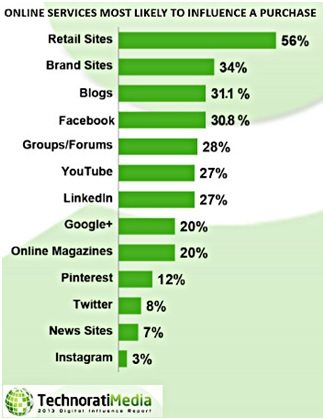I’ve previously addressed how to recruit bloggers to your affiliate marketing program. In this article, I’ll review how to engage bloggers once you’ve recruited them.
Working with bloggers takes a lot of initial elbow grease, but once the relationship is established, you are rewarded with a solid partnership that drives new, informed customers with strong lifetime value. Unlike other affiliate sites, bloggers educate their readers. When the bloggers refer these readers to your ecommerce site, the readers are typically driven by interest rather than discounts. Establishing good relationships with bloggers is important. According to a Technorati Media’s 2013 Digital Influence Report, blogs are the third most consulted source in a purchasing decision, following retail and brand sites.

Blogs are the third most consulted source in a purchasing decision, following retail and brand sites, according to Technorati Media.
For example, one of the clients I work with is an online retailer of beads and jewelry supplies. The company has very strong brand recognition within its immediate niche. However, it is lesser known to a broader audience. The client partnered with BradsDeals.com, a blog that handpicks and recommends deals to a large base of consumers. BradsDeals.com featured jewelry from our client, and in one day drove over 14,000 visitors. The program produced a standard conversion rate, but 98 percent of those sales came from new customers.
How to Engage Bloggers
So how do you get bloggers to post about you? Many bloggers offer media kits, which detail available placements and paid post rates. Paying for placement is a surefire way of getting the blogger’s attention and is a great way to start. Rates typically range from $200 to $500 per post, and you can often negotiate a reduced rate in exchange for affiliate commission. By paying for a post, you’re guaranteeing placement, but more importantly, you are signaling to the blogger that you are serious about partnering with her. However, it is very important to treat this not as a media buy, but as a true relationship. That distinction is key, because the blogger is a person, not a large company. Bloggers are relationship-driven in their interactions with their readers, and in their interactions with you.
Additionally, it’s a good idea to work with bloggers to develop the content idea. Provide them with multiple ways to position your product or brand to their readers. Also, try to customize your positioning for each blogger. Take into account the blogger’s audience demographics and the blogger’s content expertise. For example, if you are a jewelry retailer and you’re working with a mommy blogger, you might pitch family-oriented jewelry, such as a locket to hold pictures of children, or a necklace with pearls representing each child. To a food blogger, you might suggest a bracelet strung with food related charms or jewelry made from upcycled food packaging. In sum, make sure that your content pitch is relevant to the blogger’s readers.
Another way to engage the blogger is to offer samples for product reviews. Again, keep it personal and review the blogger’s site to determine a few products that you think would interest her readers, and then let her choose what to review. You can also use the same approach and offer to sponsor a giveaway.
When the blogger’s post is live, promote it through your social channels as well. Feature the post on your own blog, tweet a link to the blogger’s post, and show it off to your Facebook fans. The blogger will likely appreciate the promotion and it will help build the relationship.
Finally, share product data with your bloggers. When you’re working with a blogger through an affiliate network, the blogger can see clicks and sales that he generated, but he will likely not know the specific products underlying those clicks and sales. If you can provide this data to him, it will help with future collaboration. Look at the transactions driven by the blogger and analyze what his readers bought. Identify any trends. Share this data with the blogger so that he knows what products resonate with his audience, and can tailor future posts toward those specific tastes




